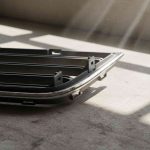Understanding Flywheel vs. Flexplate: The Foundation of Your Drivetrain
When performing clutch or transmission work, understanding the difference between flywheels and flexplates is crucial for any DIY mechanic or automotive enthusiast. Both parts bolt to your engine’s crankshaft and serve as the critical link between engine and transmission, but their design and function vary significantly based on your transmission type.
Manual Transmission: The Heavy-Duty Flywheel
A flywheel is a thick, heavy metal disc typically weighing between 15 to 50 pounds that serves three essential functions in manual transmission vehicles:
- Energy Storage and Inertia: The flywheel’s mass keeps your engine spinning smoothly between power strokes, preventing jerky operation and helping prevent stalling when you come to a stop
- Clutch Surface: Provides a smooth, machined friction surface where the clutch disc grabs to transfer power from engine to transmission
- Starter Engagement: Features a ring gear that allows the starter motor to engage and crank the engine
Automatic Transmission: The Flexible Flexplate
A flexplate is a much lighter and thinner stamped steel disc, typically weighing only 5 to 15 pounds, designed specifically for automatic transmissions. As one shop owner explains: “If you shift your gears, you’ve got a flywheel. If your transmission shifts for you, you’ve got a flexplate.”
The flexplate’s primary functions include:
- Torque Converter Connection: Connects the engine to the torque converter, which uses fluid coupling for smooth power transfer
- Starter Engagement: Like flywheels, flexplates have a ring gear for starter motor engagement
- Flexibility: The “flex” design allows adjustment to slight misalignments between crankshaft and transmission that could crack a rigid flywheel
The flexplate doesn’t need the mass of a flywheel because the torque converter fluid handles the smoothing of power pulses, making the lighter design both effective and practical.
Why Surface Condition Matters: Critical Importance for Performance
The surface condition of both flywheels and flexplates is absolutely critical for proper vehicle operation. Any damage or irregularities can lead to serious performance issues and costly repairs down the road.
Flywheel Surface Requirements
For manual transmissions, the flywheel surface is where the clutch disc mates. If this surface is uneven, scored, or warped, you’ll experience:
- Clutch chatter during engagement
- Slippage under load
- Premature clutch wear
- Difficulty shifting gears
Flexplate Integrity
While flexplates don’t serve as friction surfaces, their structural integrity is vital. A cracked or bent flexplate can cause:
- Strange rattling or knocking noises
- Lack of power transfer
- Check Engine Light activation
- Engine vibration or rattling
Where to Find Quality Used Flywheels and Flexplates
When shopping for used flywheels or flexplates, finding the right junkyard near you is essential for getting quality parts at affordable prices. Self-service salvage yards often provide the best selection and competitive pricing for these heavy drivetrain parts.
Popular salvage yard chains like Pull-A-Part and LKQ Pick Your Part typically maintain good inventories of these essential drivetrain parts across their locations.
Comprehensive Used Flywheel and Flexplate Inspection Guide
Thorough inspection is absolutely essential when considering a used flywheel or flexplate. Here’s your complete step-by-step inspection process:
Step 1: Surface Cleaning
Begin your inspection by thoroughly cleaning the surface:
- Use brake cleaner or degreaser to remove all oil and grease
- If oil or grease contamination is present, plan to replace the associated clutch disc
- Clean surfaces reveal hidden damage that dirt might conceal
Step 2: Crack Detection
Carefully inspect for cracks, as these indicate severe stress and usually mandate replacement:
| Part Type | Critical Areas to Check | Warning Signs |
|---|---|---|
| Flywheel | Entire surface, bolt holes | Surface cracks, stress fractures |
| Flexplate | Multiple spots, mating surfaces | Cracks, rust dust from rubbing |
For flexplates, rust dust forming around mating surfaces can indicate that parts have been rubbing due to cracking damage.
Step 3: Heat Spot and Scoring Inspection
Heat damage is a common issue that makes parts unsuitable for reuse:
- Look for discoloration: Blue or dark marks indicate severe overheating from clutch slippage
- Check for hard spots: Mixed soft and hard metal areas cannot be effectively resurfaced
- Assess scoring depth: Deep gouges require professional resurfacing or replacement
- Light uniform marks: Often acceptable and can sometimes be cleaned up with light sanding
“If parts of the surface are discolored, they may have hardened. A surface with a mix of soft and hard metal cannot be resurfaced effectively and will cause the new clutch to chatter, making the part non-serviceable.”
Step 4: Ring Gear (Starter Teeth) Examination
The ring gear inspection requires complete rotation of the part to examine every tooth:
- Turn the component 360 degrees using crankshaft rotation or a flywheel turning tool
- Check every single tooth for damage, wear, or missing sections
- Listen for grinding noises during startup – this indicates damaged teeth
- Replace immediately if any teeth are missing or significantly damaged
Damaged ring gear teeth are often caused by failing starter drives or incorrect starter alignment, so address these underlying issues when installing your replacement part.
Step 5: Warping and Runout Measurement
This critical step requires precision measurement tools:
- Use a dial indicator to measure runout (surface deviation from perfectly flat)
- Check manufacturer specifications – typical maximum allowable runout is around 0.004 inches
- Measure multiple points across the friction surface
- Resurface or replace if runout exceeds specifications
For flexplates, while designed to flex slightly, severe warping or permanent bending should be checked visually or with a dial indicator when possible.
Testing Used Parts Before Installation
Beyond visual inspection, testing certain aspects of your used flywheel or flexplate can prevent future problems:
Balance and Mounting Check
- Inspect bolt holes for elongation or cracking
- Check for missing or damaged balance weights
- Verify proper bolt torque specifications for your application
- Ensure mounting surface is clean and flat
Compatibility Verification
Before purchasing, confirm the part matches your specific vehicle:
- Match part numbers when possible
- Verify bolt pattern and diameter
- Check ring gear tooth count
- Confirm thickness specifications
Professional vs. DIY Assessment
While many inspections can be performed by knowledgeable DIY mechanics, some situations require professional evaluation:
| Condition | DIY Suitable | Professional Required |
|---|---|---|
| Light surface scratches | ✓ Yes | – |
| Minor runout issues | – | ✓ Machine shop resurfacing |
| Deep gouges | – | ✓ Professional assessment |
| Cracks anywhere | – | ✓ Replacement required |
Cost Considerations and Budget Planning
When budgeting for used flywheel or flexplate replacement, consider these factors:
- Part Cost: Used flywheels typically range from $50-200 depending on vehicle and condition
- Resurfacing: Professional resurfacing adds $50-100 but ensures proper clutch engagement
- Associated Parts: Budget for new clutch disc, pressure plate, and release bearing
- Labor: Consider transmission removal complexity for your specific vehicle
If you’re looking to sell your current vehicle for cash rather than repair it, getting multiple quotes can help you make the most cost-effective decision.
Safety Considerations and Red Flags
Never compromise on safety when evaluating used drivetrain parts. Here are absolute red flags that should stop you from purchasing:
- Any visible cracks – regardless of size or location
- Missing or severely damaged ring gear teeth
- Heat damage or discoloration indicating overheating
- Excessive runout beyond manufacturer specifications
- Evidence of previous welding repairs
“Driving with a damaged flexplate or flywheel is not recommended as they are crucial for controlling vehicle speed and power output.”
Installation Best Practices
Once you’ve found and inspected a suitable used flywheel or flexplate, proper installation ensures optimal performance:
Preparation Steps
- Clean all mating surfaces thoroughly
- Apply thread locker to bolts as specified
- Use a torque wrench for proper bolt tightening
- Follow manufacturer’s torque sequence
Quality Control Checks
- Verify smooth rotation after installation
- Check for any unusual vibrations
- Test starter engagement
- Monitor for unusual noises during initial operation
Maintenance Tips for Extended Life
Maximize the life of your used flywheel or flexplate with proper maintenance:
- Address clutch problems promptly to prevent flywheel damage
- Use proper driving techniques – avoid riding the clutch
- Regular transmission service keeps automatic systems healthy
- Monitor starter operation to prevent ring gear damage
- Check engine mounts to prevent excessive flexplate stress
Final Thoughts: Making the Smart Choice
Finding and inspecting a used flywheel or flexplate requires patience, knowledge, and the right tools. While it’s generally not ideal to reuse clutch parts, budget constraints sometimes make it necessary. The key is thorough inspection and honest assessment of the part’s condition.
Remember that these parts are crucial for your vehicle’s operation. When in doubt, consult with experienced mechanics or consider investing in professional resurfacing. The additional cost upfront can save you significant money and frustration down the road.
Whether you’re working on a Honda Civic restoration project or need parts for a Ford F-150 repair, taking the time to properly inspect these critical drivetrain parts will ensure reliable performance and help you avoid costly comebacks.





Leave a Reply
You must be logged in to post a comment.